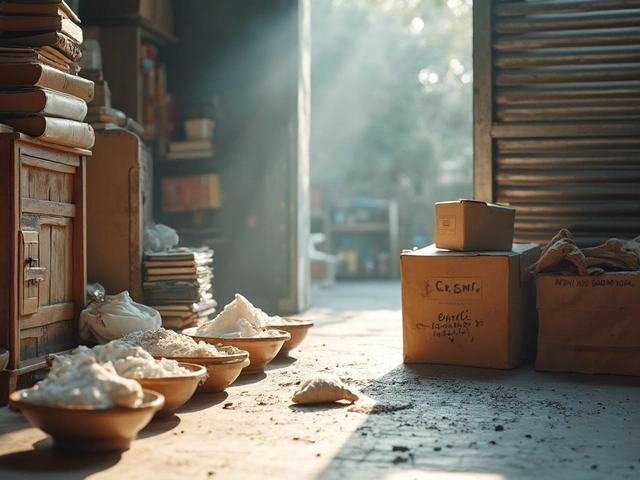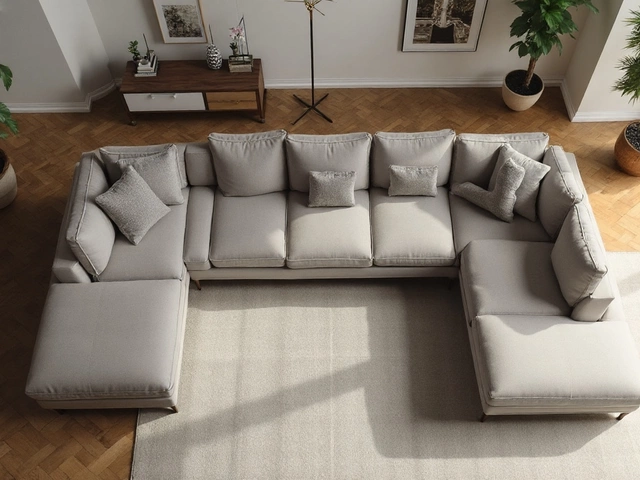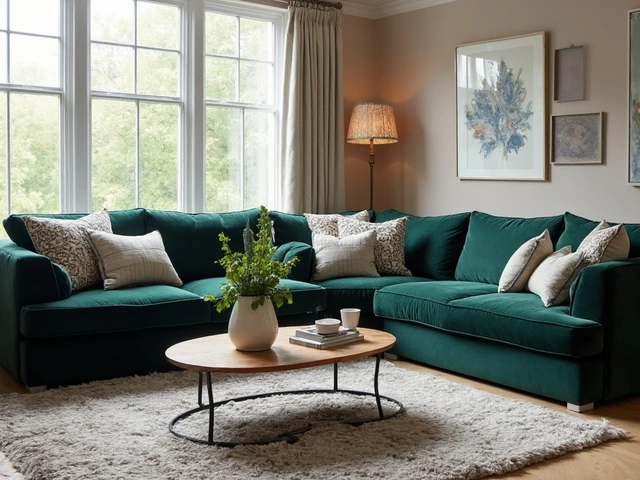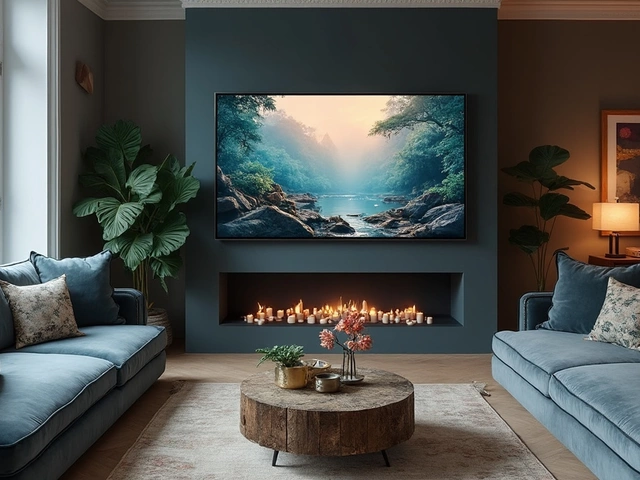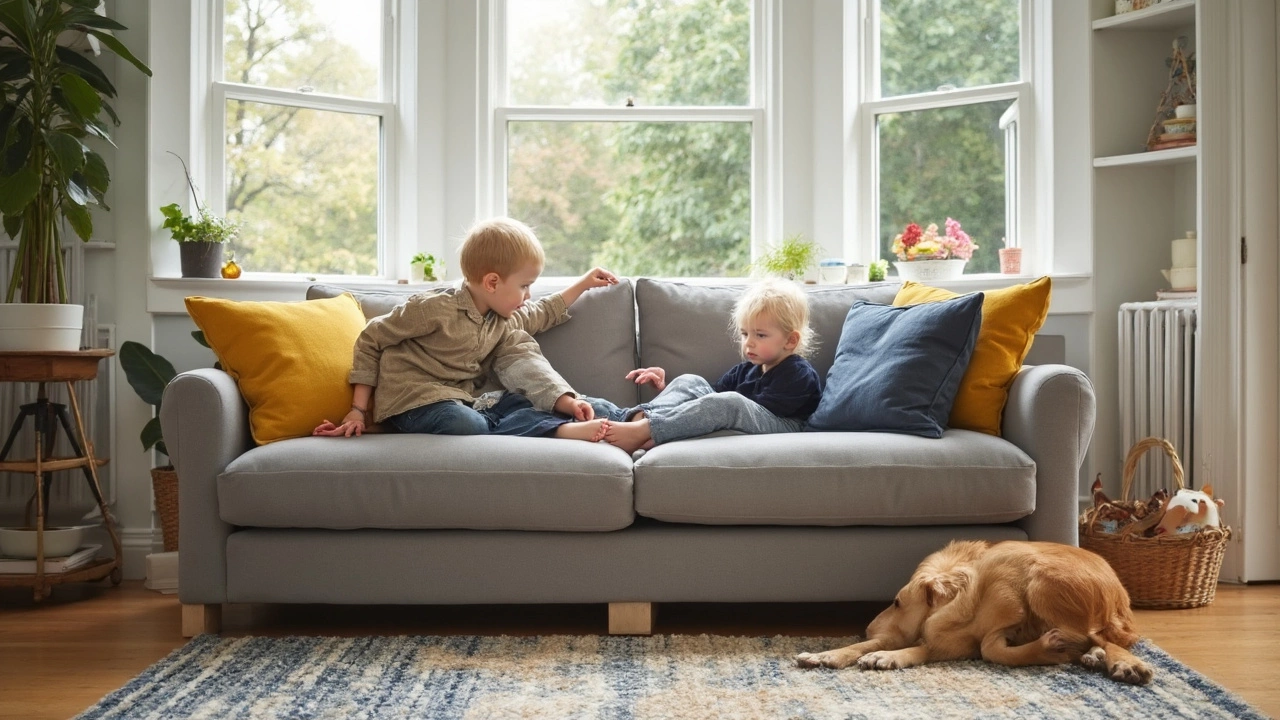 4
May,2025
4
May,2025
Few things are more annoying than watching your brand-new couch get wrecked by a muddy paw or a spilled coffee. Let’s face it—no matter how careful you are, life just happens. Whether you have kids, pets, or a love for red wine, the color of your couch will absolutely decide how much you’ll stress about stains and hand prints.
If you want a sofa that doesn’t look dirty two days after shopping, you need to nail the right color. Here’s the funny thing: most people assume jet black hides everything, or that white means disaster. But it’s not that simple. The truth is, some colors do a much better job masking everyday dirt and little marks. You’re not looking for something that’s spotless all the time—you want something that makes the messes much less obvious between cleans.
- The Psychology of Color and Dirt
- Best Colors for Hiding Everyday Messes
- Fabrics That Help Hide Stains
- Staying Practical: Life with Kids and Pets
- Care Tips to Keep Sofas Looking Fresh
- Real-World Color Choices and Style
The Psychology of Color and Dirt
When you’re choosing a sofa color, you’re probably thinking about style first. But color doesn’t just affect how your living room looks—it actually changes how clean (or messy) your couch appears on a daily basis. Our brains notice contrasts, not tiny particles. Basically, the bigger the difference between your couch and a stain, the more it pops out. So, dark chocolate on a white couch is eye-catching, but chocolate on a brown or patterned sofa practically vanishes.
Certain colors just naturally hide more dirt. Think about it: medium grays, muddy taupes, or earthy greens tend to swallow up stains, dust, and those random potato chip crumbs. Light or bright colors, like white or pale yellow, show everything, because every smudge is basically screaming, “Hey look at me!” Super dark colors like deep navy or black sometimes backfire, too. They pick up lint, pet hair, and light dust, and those show up like a neon sign.
There’s actually a little fun science behind what tricks our brains. A 2022 survey by a major furniture retailer found that sofas in ‘greige’ or dark olive were voted the best at hiding day-to-day messes by over 65% of parents and pet owners. That’s because those couch cleaning colors mask stains and wear way better than pure white or solid black.
| Sofa Color | Visibility of Dirt/Marks |
|---|---|
| White | High |
| Medium Gray | Low |
| Dark Blue/Black | Medium/High (dust, hair) |
| Beige/Taupe | Low |
| Dark Green | Low |
So if you want less fuss, steer toward middle shades and earthy tones. These colors draw less attention to minor stains, marking them the MVPs of a tidy-looking sofa. Remember, it’s not just about hiding mud—it’s about what tricks your eyes the best into thinking the space is clean, even on busy days.
Best Colors for Hiding Everyday Messes
Now, let’s get real: not all sofa color choices are equally clever if you want to hide dirt and daily messes. Some shades can save your sanity, while others will have you busting out stain remover every week. Here’s what works best when you want your couch cleaning routine to be less of a pain.
Tans, grays, and muted earth tones are hard to beat. They’re famous for making crumbs, dust, and even pet hair less of a nightmare. Mid-tone grays especially have a loyal fan base for this reason—they don’t show every little mark, and they go with almost any living room style. In fact, a poll by a big home decor retailer in 2024 showed that 37% of customers picked gray sofas specifically because they show less dirt.
Brown is another classic. Medium to dark browns can handle most of what family life throws at them—think chocolate ice cream stains or muddy shoes. You might want to avoid super dark colors like deep black or navy, though. You’d think they’d be the kings of hiding everything, but dust and light-colored lint can stand out like sore thumbs, especially under bright lights.
Patterns are the secret weapon people often forget about. A subtle print, like small checks or a gentle texture, can make crumbs and tiny smudges practically disappear. It’s way easier to live with than a solid white or beige, which will put every coffee spill or pencil mark on blast. Here’s a breakdown that sums up which sofa color shades do the best job under real-life living room conditions:
| Color Family | Best For Hiding | Can Show |
|---|---|---|
| Gray (Medium) | Dirt, dust, pet hair | Not much, blends most stains |
| Brown (Medium) | Dirt, food stains | May show very light dust |
| Patterned (Neutral) | Crumbs, smudges, spills | Nothing stands out |
| Navy/Dark | Dark spills, food | Shows dust, pet hair |
| Cream/White | Not much | Shows nearly everything |
So if you want a sofa color that gives you less grief, aim for mid-tone grays, taupe, or a smart pattern. If your pets shed a lot, try to match the sofa color to their fur. It sounds simple, but it makes a huge difference in how tidy your space feels day to day.
Fabrics That Help Hide Stains
Getting the sofa color right is only half the deal—a lot depends on the fabric. Some materials are basically dirt magnets, while others shrug off spills and let you relax. If you’re serious about picking a couch that hides more than it shows, pay attention to this list.
Microfiber is a game changer. It has tightly woven fibers, so dirt and crumbs don’t get ground in, and spills sit on top longer before soaking in. People say microfiber is a pet owner’s best friend since fur brushes right off and most stains can be tackled with just soap and water.
If you’re set on something that looks upscale but still practical, consider leather. Now, not all leathers are made equal. Real leather is easier to wipe clean, but darker shades do a much better job hiding wear, scratches, and those mystery smudges. Faux leather is even more fuss-free when it comes to cleaning—just a quick wipe most of the time.
For families with messy kids or folks who love movie nights with snacks, textured fabrics like tweed or subtle herringbone patterns work surprisingly well. The little flecks and patterns distract from small stains and dirt. Plain, flat-woven cotton might look nice in a showroom, but in real life, everything sticks to it and stains show up easily.
- Microfiber: Resists spills, pet hair brushes off, hides water marks
- Leather or Faux Leather: Easy to wipe, hides most stains, scratches less obvious in darker tones
- Tweed or Patterned Fabrics: Patterns camouflage small messes, hold up well to everyday use
- Performance Fabrics (like Crypton): Specifically designed to repel stains, water, and smells
Here’s a quick comparison of common sofa color and fabric choices when it comes to hiding dirt:
| Fabric Type | Best Colors | Hides Dirt? | Easy to Clean? |
|---|---|---|---|
| Microfiber | Gray, taupe, brown | Yes | Yes |
| Leather | Dark brown, black, navy | Yes | Yes |
| Tweed/Patterned | Multicolor, medium tones | Yes | Depends |
| Cotton (plain) | Any | No | No |
If you’re picking a sofa set for real, messy life, skip anything that feels like velvet or silk unless you’re a pro at spot cleaning. Go for a sturdy, low-maintenance fabric paired with that just-right shade—a combo that keeps you from pulling your hair out over every little spill.
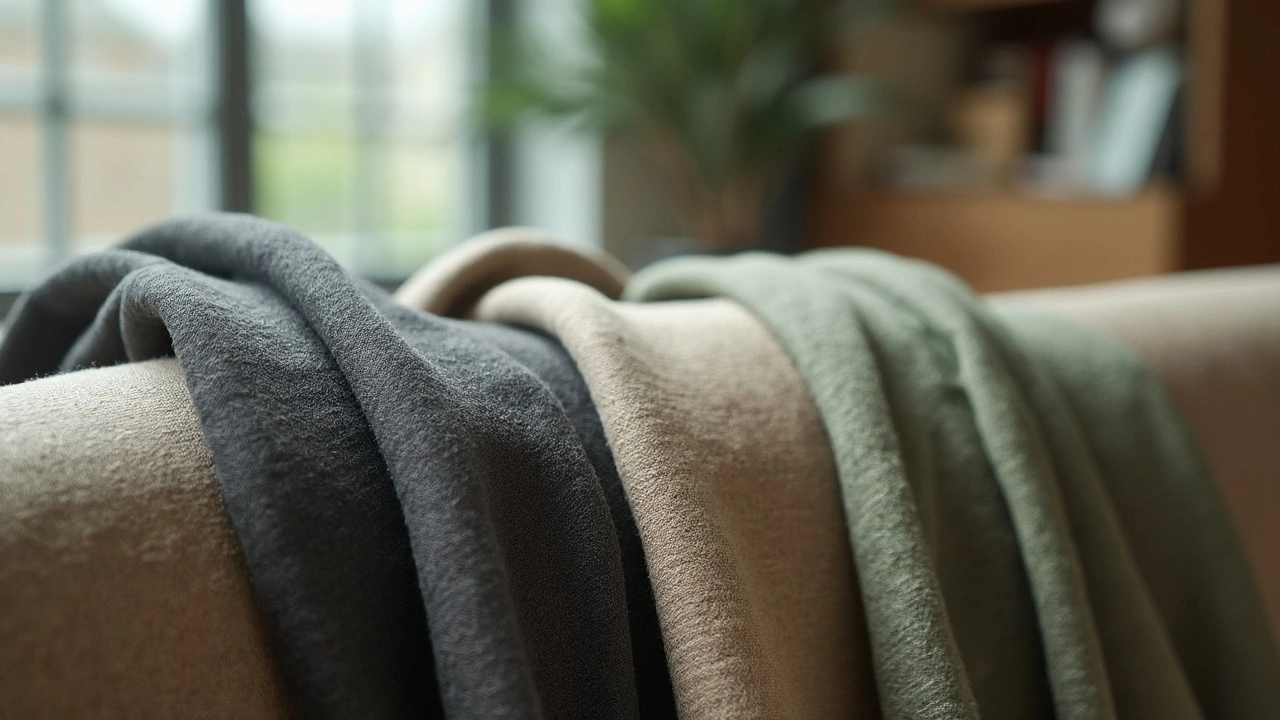
Staying Practical: Life with Kids and Pets
If you live with kids or pets, your couch cleaning routine probably feels nonstop. Juice spills, cookie crumbs, muddy paws—these aren’t rare events, they’re daily life. So, picking a sofa color that hides dirt and stains isn’t just nice to have, it’s basically a survival tactic for your furniture.
Mid-tone shades give you the best shot at sanity. Grays, taupes, and even muted greens or blues tend to camouflage most little messes without looking too dark (which can show lint and pet hair) or too light (which flashes every fingerprint). Brown and charcoal are popular for families with kids because they mark a sweet spot between hiding stains and still looking stylish.
Patterned fabrics are your secret weapon. Small-scale prints, subtle tweeds, or textured looks scatter marks so you don’t see every single oops. For example, a couch with a gray and beige heathered weave fends off the evidence of both chocolate and dog hair. Pet owners especially benefit from patterns—dogs and cats shed, jump, and drool without a care in the world.
Now, about furniture tips: Some materials handle chaos better than others. Microfiber, for instance, isn’t just soft; it’s famous for resisting stains and wipes clean with a damp sponge. Real leather also shrugs off most spills, but watch out for sharp claws, which can scratch.
Kids and pets tend to mess up sofas in specific ways. Here’s what usually happens and how different colors stack up:
| Type of Mess | Best Masking Colors | Worst Masking Colors |
|---|---|---|
| Pet Hair (Light) | Beige, gray, taupe | Black, navy |
| Pet Hair (Dark) | Charcoal, navy | White, cream |
| Juice or Food Stains | Gray, earth tones | Pastels, white |
| Grass/Dirt | Brown, olive, slate | Light blue, cream |
If you want to cut down on visible mess and cleaning burnout, follow these quick tips:
- Choose mid-toned, multi-colored, or patterned upholstery over solid light or dark colors.
- Use washable slipcovers when possible, especially if your kids like to snack on the couch.
- Scout out stain-resistant fabrics, including some modern options that look like linen but repel liquids.
- Keep a pet blanket handy for your furball’s favorite napping spot—this buys your living room seating much more time between scrubs.
Bottom line: If you’ve got a wild household, skip white and black couches. Go for medium tones, clever patterns, or anything textured. This small choice can save you loads of headaches and keep your sofa sets looking fresh way longer than you’d expect.
Care Tips to Keep Sofas Looking Fresh
Let’s be honest: even the best color choice for your sofa color won’t do all the work. If your couch is a big part of your life, dirt and crumbs are always going to find their way in. You don’t have to work overtime to keep things neat, though. Here’s what actually moves the needle when you want a couch that keeps looking clean without constant hassle.
- Vacuum regularly: Once a week is the sweet spot, especially if you have pets or kids. Make sure to get into creases and under cushions. Most vacuums have attachments made just for furniture.
- Spot clean ASAP: If you see a spill or smudge, don’t wait. Dab (don’t rub) with a clean cloth and a little water, or a gentle fabric-specific cleaner. Even just warm water and a bit of mild dish soap can work wonders on the right fabrics.
- Rotate cushions: Flip and shuffle the cushions every couple weeks. This helps avoid uneven fading and weird dirt patterns, especially on lighter fabrics.
- Use slipcovers or throws: This is a game-changer for light or dark sofa color in high-traffic homes. You can toss them in the wash, and they come in styles that don’t look like an afterthought.
- No food rule (mostly): If you can keep snacks and meals away from your main sofa sets, you’ll seriously reduce the number of mystery stains. If not, at least keep a side table nearby so spills are less likely to land on the fabric.
Fabric matters, too. Microfiber and performance fabrics designed for sofa sets are way easier to clean than traditional cotton or linen. Some brands use stain-resist technology that really works, letting you wipe off most spills before they soak in. Leather is another easy-wipe option, but light leather still shows dirt more than mid-tones or dark tones.
| Care Tip | How Often | Best For |
|---|---|---|
| Vacuum | Weekly | All fabrics |
| Spot clean | As needed | Spills |
| Rotate cushions | Bi-weekly | Sectionals, large sofas |
| Wash slipcovers | Monthly | High traffic homes |
It doesn’t have to take all weekend, either. Little habits can buy a lot more life—and way less stress—out of any sofa color you pick.
Real-World Color Choices and Style
If you walk into most homes trying to keep things low-maintenance, you’ll spot a lot of mid-toned couches: think grays, beiges, or gentle browns. These colors rule the world of sofa color because they strike the right balance—neither too light to show every crumb, nor so dark that lint and dust scream for attention. Designers actually swear by these shades because you can spill a bit, forget to vacuum for a week, and the couch will still look presentable.
For the record, pure white sofas look stunning in magazines, but in a real living room—especially if you’ve got kids, dogs, or even a fondness for nachos—they’re almost impossible to keep clean without a professional cleaner on speed-dial. On the flip side, super-dark colors like navy and black might seem like an easy fix. The catch? They show everything from pet hair to lint and even light-colored crumbs. It’s kind of a trade-off—dark colors often need more lint-rolling, while lighter ones reveal spills and stains.
According to Emily Henderson, a well-known interior designer, “
If hiding dirt is a top priority, go for a medium-tone fabric with a textured weave—it hides way more than you think and looks good in almost any style of room.” That texture adds an extra trick, camouflaging dirt even better.
Want to get even smarter about your couch cleaning routine? Here’s how the top sofa shades actually stack up in busy homes:
| Sofa Color | Hides Dirt | Shows Lint | Style Flexibility |
|---|---|---|---|
| Mid-gray | Excellent | Low | High |
| Beige/Taupe | Very Good | Low | High |
| Charcoal/Navy | Good | Medium-High | Medium |
| Patterned | Excellent | Depends | Medium |
| Cream/White | Poor | Low | Low-Medium |
If you love a pop of color, don’t be afraid to pick deeper jewel tones like emerald green or slate blue. They hide messes better than brights, but still look lively and modern. Want to experiment? Removable covers or slipcovers in a forgiving color can change the vibe and save you stress on cleaning days.
At the end of the day, the best sofa color is the one that suits your lifestyle. Go for colors and patterns that make messes less obvious, but still fit your style. Life is messy, but your living room doesn’t have to look like it’s at battle every day.
